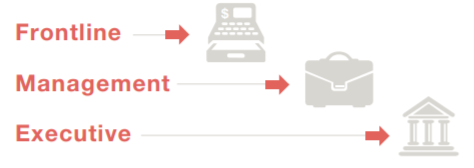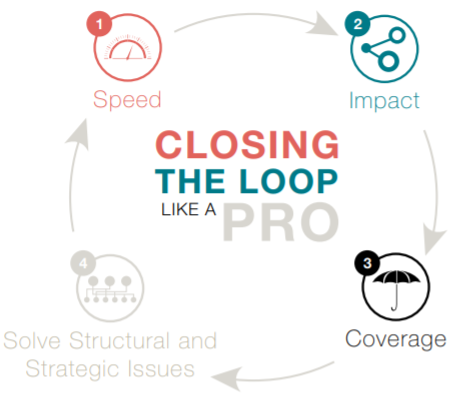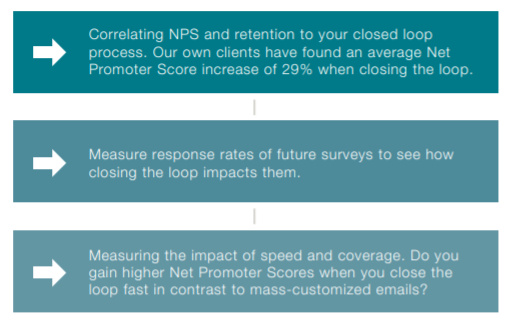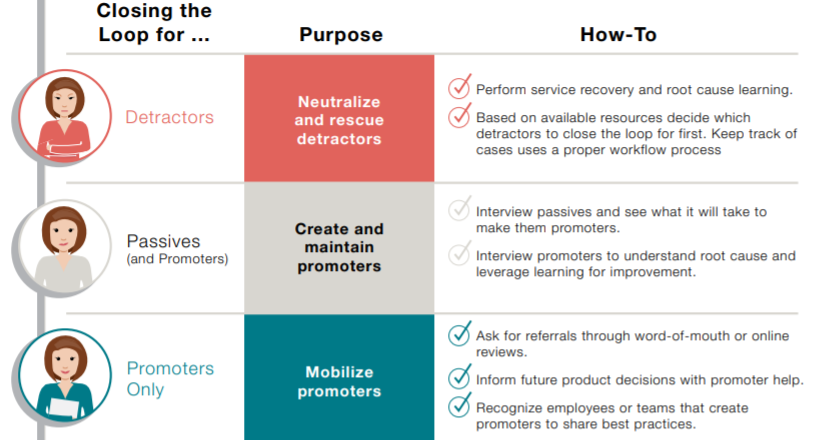Introduction
Welcome to step 2 of our Monetized NPS eBook series. In our last installment, we discussed how companies should measure and analyze Voice of Customer (VoC) to gain an understanding of brand sentiment. In this eBook, we’ll discuss the second step in mastering Monetized Net Promoter: acting on customer feedback.
Remember, NPS® is an actionable metric, meaning that surveying your customers is only the first step. You also need to act on the feedback you receive. Companies do this by closing the loop with customers at different levels of their organization and optimizing business processes by setting realistic targets for future growth.
With structured processes, companies can address both operational and strategic issues as well as close the loop by communicating their actions and progress back to customers.
Act is a vital stage in the Monetized Net Promoter model, as it opens a true dialog between customers and companies, allowing organizations to learn from and fix mistakes in the customer journey. Only by acting can you hope to begin improving your Net Promoter Score®.
In this eBook, we’ll dive deep into closed-loop and optimization techniques within the Act stage.

Table of
Contents
- Part I: Closing the Loop
- Defining a Good
- Closed Loop Process
- Closing the Loop at the Frontline
- Closing the Loop at the Management & Executive Level
- Part II: Optimizing
- Setting S.M.A.R.T. Goals
- Defining What-If Scenarios
- Conclusion
- About Us
Part I:
Closing the Loop
Part I: Closing the Loop
Closing the loop is necessary to determine root cause, improve customer experience and retention, rescue detractors and maximize promoters.
The closed-loop process happens at three levels of an organization, depending on the type of issue and escalation involved. These levels are:

For any NPS program to be successful, it’s imperative that companies have the processes in place to close the loop at each of these levels.
Depending on whether your company is primarily B2C or B2B, you’ll close the loop with either customers or accounts. When it comes to closing with accounts, companies should consider conducting quarterly business reviews to assess program goals and set expectations.
In this chapter, we’ll discuss the closed-loop process of Monetized Net Promoter and describe best practices for acting on customer feedback in your NPS program.
Defining a Good Closed Loop Process
There are four elements to a well-defined closed loop process: speed, impact, coverage, and structural/strategic issues. Let’s walk through each.

Defining a Good Closed Loop Process
1. Speed
The speed at which you close the loop can play a big part in negating churn and increasing promoters. More than 50% of customers answer surveys in less than 24 hours.
How fast you respond to their feedback and take action to resolve issues is essential. A best practice is to respond within 48 hours, as this ensures the response is still at mind.
It’s important that your closed-loop process is effortless for the customer. The process should not feel like another touch point to the customer, but rather as a natural follow-up. A good example of this is refining call scripts so the customer spends as little time with you as needed, but gets as much out of it as possible.

Defining a Good Closed Loop Process
2. Impact
A good closed-loop process should measure the impact of your customer experience efforts. For example:

Defining a Good Closed Loop Process
3. Coverage
You should strive to close the loop for as many customers as possible. Doing so will allow you to have a clearer picture of root cause based on the larger population size of your NPS data.
However, since responding to each and every customer can be grueling due to limited resources, the best way to ensure closed loop coverage is through automation. Automate your feedback through emails or newsletters, explaining what you learned and what you plan to do or have already done.
This type of communication can serve a purpose outside your respondent base as well. Send a quick update to your non-survey taking audience explaining how you adjust your business to the needs and wishes of people answering your survey. This is an advanced strategy that not many businesses utilize, however those who do have found it boosts future response.
4. Solve Structural and Strategic Issues
The frontline of your company can handle most operational issues. However, many companies struggle with issues that require crossorganizational cooperation, investments or even strategic changes. A good closedloop process will have the steps in place for issues that require structural or strategic-based support that involve upper-management. These issues appear early on in the program, but if you lack a process to deal with them, your closed-loop process is incomplete.
Closing the Loop at the Frontline
Now that we’ve gone through the finer points of a well-defined closed loop process, let’s jump into implementing processes for each level of your organization. Depending on whether your company is B2C or B2B, the frontline will either close the loop with respondents or accounts:
1. Respondents
As part of the follow-up process, the frontline will call back respondents to: a) Ask for root cause of a score, if it is unclear, b) Fix open issues with detractors and passives, c) Understand what it takes to turn a passive into a promoter, and d) Understand reasons for promotion and encourage referrals.
2. Accounts
Reviewing scores, drivers and comments in a client meeting allows an account manager to prioritize actions with the client, add them to the account plan and follow-up in later meetings.
The speed at which one closes the loop at the frontline is also important to retention. In fact, companies that have their frontline close the loop between 48 hours to 2 weeks increase retention by up to 5.5%. In addition, how many customers the frontline closes the loop for also impacts retention. Companies that close the loop with all their customers can improve retention by more than 6%.

Closing the Loop at the Frontline
A fully flesh-out closed loop process closes the loop with not only detractors, but passives and promoters as well.

Closing the Loop at the Management and Executive Level
Closing the loop is often only discussed at the frontline. However, some tasks may require help from management or even the executive level.
When closing the loop at the management level, managers should identify how NPS
drivers correlate to business functions and what improvement to those drivers will help grow NPS. For example, in the CustomerGauge system, managers can track the frequency and history of driver performances over time. This will allow them to pinpoint what drivers within the business will lead to the highest bang for
their buck.
In the same vein, managers are responsible for breaking down this information to inform best practices across business units, as well as track performance across locations.

Part II:
Optimizing
Part II: Optimizing
Once you’ve defined a good closed loop process for each level of your organization, you can begin optimizing business processes based on discovered best practices.
Shockingly, based on our research, we found that 21% of companies do not set targets on how much their NPS or retention should grow. As a result these same companies, on average, only grew retention by 2.6%, while companies who did set targets grew more than 4.5%.
Many companies simply don’t know what sort of targets or benchmarks they should be setting for themselves. Skilled NPS practitioners will typically employ S.M.A.R.T goals, which set reasonable expectations based on a number of factors and trends within their historical data. If you remember from our previous eBook, MeasuringNPS, we discussed how companies can utilize predictive churn analytics based on historical data to gain an understanding of future churn trends. Companies may use similar methods when setting targets.
Use what-if scenarios and follow-up questions to scores to understand what would have a positive impact on NPS and customer retention.

Setting S.M.A.R.T. Goals
Acting to improve customer experience, retention and NPS occurs beyond just reacting to customer feedback. It should also happen internally. S.M.A.R.T goals are one way companies can define reasonable and realistic targets for their program. S.M.A.R.T goals are Specific, Measurable, Assignable, Realistic and Time-Related. Examples of S.M.A.R.T goals within an NPS program could be:
• The South-America Region should improve NPS by 10 points by year-end.
• The company should survey the top 75% clients and achieve a 60% response rate.
• Frontline should close the loop within 2 days for all detractors and within 7 days for all passives
But, how can you make a goal S.M.A.R.T?
s-Specific
When setting targets, specificity is important. Let’s say, for example, you want your Net Promoter Score to be 65, which is within the range of your industry’s benchmark. Is this NPS of 65 cumulative (i.e., is this a company-wide target). Is it best to set NPS score goals by division? And, if so, is 65 a fair cross-department score, or should scores be set individually?
In the same vein, should KPI targets be set for other facets of your NPS program, such as response rates?
Specificity is vital to ensuring comprehension of goals across departments so employees understand what is expected of them. General, non-specific goals will often paint a half-picture of your program’s success. When measuring the success of your program, it’s best to show the c-suite fleshed-out goals.
Setting S.M.A.R.T. Goals
M-Measurable
Do you have the tools in place to measure the progress of a defined goal? By nature, NPS is a measurable metric—your response rates and case management should be as well. You should have an automated Net Promoter System in place that will allow you to easily track and document these types of metrics.
A-Assignable
Depending on how you define the acronym, any SMART goal should be assignable and achievable. Assignable infers that you have the people and/or capabilities in place to actually make that happen. For example, if you don’t have the amount of staff in place to close the loop within 10 hours, you can’t assign this to a department and expect miracles to happen.
R-Realistic
Improving your NPS score by 5 points over a year, or even less, especially if you send a large number of surveys, should still be considered a noteworthy achievement. So be realistic with the targets you set.
T-Time-Related
It’s one thing to set goals, it’s another to actually make them happen. If you don’t put deadlines on the goals you set, they’re essentially unmeasurable. Many companies will use quarterly goals to keep track of progress. This allows them to more consistently capture issues and share best practices throughout the year.
Defining What-If Scenarios
What-if scenarios are a standard business technique used to predict the plausibility of goals based on trends. This can be used to calculate how the Net Promoter Score will improve within a chosen scenario.
In our Closing the Loop eBook, we discuss how one of our customers, an IT company, conducted simple “what-if” scenarios. Based on customer feedback from their detractors and passives, they discovered that they could increase their NPS score by 8 points by updating their manuals more frequently to better reflect new features. They were also able to determine that for each extra NPS point, they would gain an additional 0.5% sales increase. This translated into an additional 4% yearly increase in sales.
As a result of this information, they hired out more technical writers to improve their manuals and post them online for easy access. The executive level, to ensure transparency among customers about the new change, launched a marketing campaign to inform customers about the changes made, as well as thanking them for bringing the issue to their attention.
We gave this example from our past eBook as it shows the moving pieces of the Act stage working together:

Conclusion
Taking action on customer feedback is the most vital step in improving your Net Promoter Score, reducing churn and increasing retention. As the second step in our Monetized Net Promoter series, it plays a pivotal role in fully integrating feedback into the decision-making process.
Throughout this eBook, we covered what a good closed-loop process looks like,
including implementing a closed-loop strategy at every level of your organization
to ensure you are responding to the needs of your customers. After you close the
loop, we discussed how no NPS program can ever be successful without setting
S.M.A.R.T targets and defining what-if scenarios to prepare for the future.
